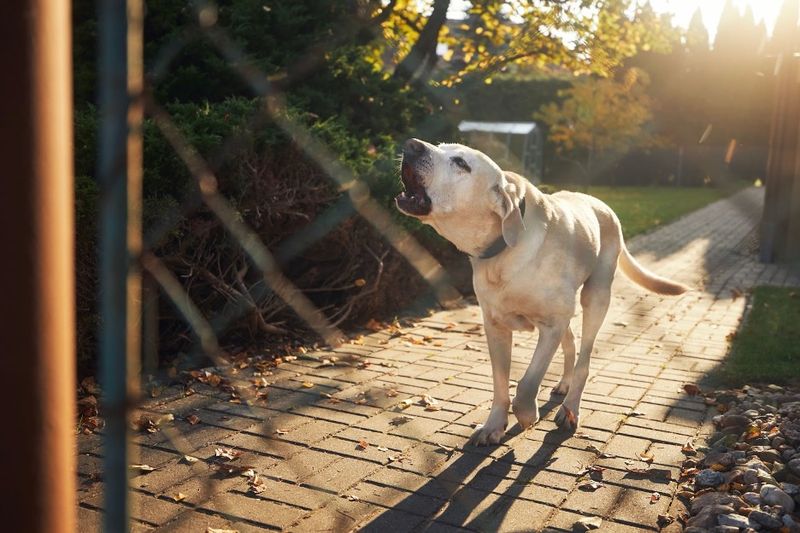15 Reasons Why Dogs Bark At Strangers

Ever wondered why your furry friend barks at every passerby?
Whether it’s the mailman or a mysterious stranger, dogs have a variety of reasons for barking at newcomers. It’s not just noise; it’s a form of communication and expression for them.
1. Protective Instincts

With a gaze sharper than an eagle’s, many dogs bark at strangers to defend their homeland. They perceive unfamiliar faces as potential threats, and their barking acts as an alarm system.
This protective instinct is deeply ingrained, serving as a throwback to their wild ancestors. Whether it’s a bark of warning or merely a show of strength, these loyal guardians have their family’s back.
2. To Alert Their Owners

Imagine a four-legged alarm clock! Dogs often bark at strangers to alert their owners of a new presence. This behavior ensures that their human companions are aware of any potential visitors or intruders.
It’s like having a furry security guard on duty 24/7. For many, this is both a comfort and a reminder of the dog’s dedication to keeping its family informed and secure.
3. Fear Or Anxiety

In the world of dogs, the unfamiliar can be intimidating. Some dogs bark due to fear or anxiety, especially if they haven’t been exposed to many new faces. Past negative experiences can heighten this response, making the world seem a bit scarier.
This anxious barking is their way of coping with new situations, seeking reassurance, or attempting to deter what they perceive as a threat.
4. Territorial Behavior

Dogs are natural boundary setters. When strangers approach, dogs bark to declare their territory. It’s their way of saying, “This is my space, buddy!”
This territorial barking can be fierce, meant to ward off intruders and establish dominance. Whether it’s the mailman or a new neighbor, dogs take territorial integrity seriously, and their bark echoes their commitment to their domain.
5. Socialization Needs

For dogs, the unknown can be daunting, especially if they’re not well-socialized. Barking at strangers may simply be an expression of their discomfort and unfamiliarity. These barks are cries for more social experiences and exposure to new people.
Over time, with gradual encounters, these dogs may learn to embrace the diversity of human personalities without the need for vocal protest.
6. Excitement Or Curiosity

With eyes wide and tails wagging, some dogs greet strangers with a bark of pure joy. It’s not about fear; it’s all about excitement and curiosity. These dogs are eager to meet, play, and explore the new person they see.
Their barking is like a cheerful invitation to engage, a sign of their playful and inquisitive nature, ready to make a new friend at any moment.
7. Seeking Attention

Some dogs are attention seekers, and barking at strangers is just another way to get noticed. “Pay attention to me!” their bark seems to say. This behavior might stem from a desire for interaction, pats, or simply acknowledgment.
For these social butterflies, being ignored is not an option, and they’ll use their voice to ensure they’re in the spotlight, even if just for a moment.
8. Lack Of Proper Training

Without the right guidance, some dogs bark out of sheer habit. Training plays a crucial role in teaching dogs how to behave calmly around strangers.
When that guidance is missing, barking becomes their default response to excitement, fear, or curiosity. With consistent training and positive reinforcement, dogs can learn to greet newcomers with more restraint—and a lot less noise.
9. Previous Bad Experiences

Sometimes, the past casts a long shadow. Dogs with negative memories of strangers may bark as a defense mechanism. This behavior is rooted in self-preservation, a way to protect themselves from potential harm.
Their bark is a reminder of past encounters, a cautionary tale told through sound. Helping these dogs overcome their fears requires patience, understanding, and a lot of love.
10. Anxiety From New Situations

Change can be unsettling, especially for sensitive dogs. When faced with new situations or unfamiliar faces, some dogs bark to express their discomfort or stress. This anxious barking is a reaction to the unknown, a vocal manifestation of their need for stability.
By gradually introducing them to new experiences, owners can help their dogs adapt more comfortably to life’s many surprises.
11. Communication With Other Dogs

It’s not just humans who communicate through barking. Dogs may bark at strangers to signal other dogs. Whether it’s a call of warning or a shout of excitement, it’s all about sharing information.
This canine chatter can alert others to a newcomer’s presence, creating a network of communication that transcends fences and yards. It’s like a neighborhood watch, but with wagging tails.
12. Dislike Of Unfamiliar Scents

With noses that can detect the faintest whiffs, dogs may bark at strangers due to unfamiliar scents. This olfactory suspicion arises when a new person smells different, triggering a cautionary bark.
Their sense of smell is a vital tool for understanding the world. Whether it’s a new perfume or a foreign odor, a dog’s bark is its way of processing and responding to unfamiliar aromatic cues.
13. Protecting Their Pack

In the heart of a canine lies a pack animal, ever vigilant of its group. Barking at strangers is one way dogs ensure the safety of their family. This protective behavior is instinctual, manifesting as a loud declaration of loyalty.
To the dog, every bark serves as a shield, defending its human companions from the unknown. It’s the vocal embodiment of the phrase, ‘I’ve got your back.’
14. Overstimulated Or Hyperactive Behavior

For some dogs, the world is a thrilling playground. Overstimulated and bubbling with energy, they bark at strangers out of sheer exuberance. It’s not about fear or aggression—it’s about expressing their boundless enthusiasm.
These lively barks are part of their hyperactive nature, a joyous outburst that reflects their zest for life. Encouraging calm behavior through training can help manage their excitement.
15. Desire For Control

Some dogs feel the need to call the shots. Barking at strangers is their way of asserting dominance or control over the situation. This vocal assertion of authority is more about establishing hierarchy than aggression.
In their eyes, it’s about setting the rules and maintaining order. Through proper training and leadership, these dogs can learn to channel their need for control into positive interactions.






